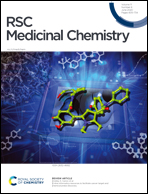Radiosynthesis and evaluation of 4-(6-[18F]Fluoro-4-(5-isopropoxy-1H-indazol-3-yl)pyridin-2-yl)morpholine as a novel radiotracer candidate targeting leucine-rich repeat kinase 2
Abstract
Mutations that increase leucine-rich repeat kinase 2 (LRRK2) activity in the brain are associated with Parkinson's disease. Here, we synthesized a novel compound 4-(6-fluoro-4-(5-isopropoxy-1H-indazol-3-yl)pyridin-2-yl)morpholine (FIPM) and labeled it with fluorine-18 (18F), to develop a positron emission tomography (PET) tracer for in vivo visualization of LRRK2 in the brain. FIPM showed high in vitro binding affinity for LRRK2 (IC50 = 8.0 nM). [18F]FIPM was prepared in 5% radiochemical yield (n = 5), by inserting 18F into a pyridine ring, followed by removal of the protecting group. After HPLC separation and formulation, [18F]FIPM was acquired with >97% radiochemical purity and 103–300 GBq μmol−1 of molar activity at the end of radiosynthesis. Biodistribution and small-animal PET studies in mice indicated a low in vivo specific binding of [18F]FIPM. While [18F]FIPM presented limited potential as an in vivo PET tracer for LRRK2, we suggested that it can be used as a lead compound for developing new radiotracers with improved in vivo brain properties.
![Graphical abstract: Radiosynthesis and evaluation of 4-(6-[18F]Fluoro-4-(5-isopropoxy-1H-indazol-3-yl)pyridin-2-yl)morpholine as a novel radiotracer candidate targeting leucine-rich repeat kinase 2](/en/Image/Get?imageInfo.ImageType=GA&imageInfo.ImageIdentifier.ManuscriptID=C9MD00590K&imageInfo.ImageIdentifier.Year=2020)


 Please wait while we load your content...
Please wait while we load your content...